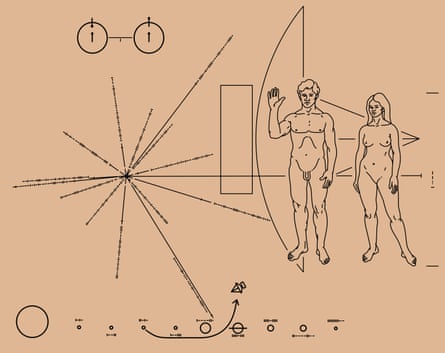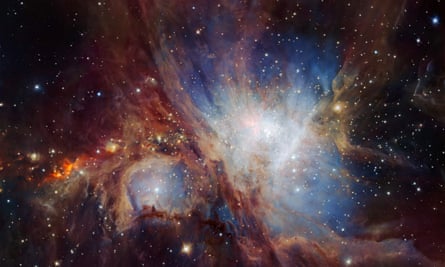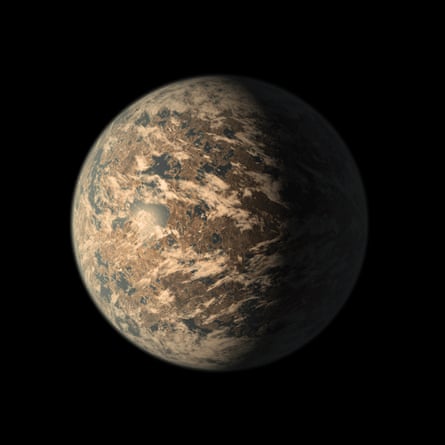Astronomy and cosmology can feel detached from everyday reality. But what if we could take a 23rd-century starship tour through the Milky Way and experience the cosmos like an Earth-bound tourist visiting exotic destinations? What would we see from our window?
Although physicists enjoy speculating about warp drives, or using wormholes to jump between locations, there is no way to travel faster than light at present. So we’re assuming a fictional ability to do this – but beyond that, everything we will encounter on our voyage is based on best current theories.
Passing other probes
As we exit the solar system and enter interstellar space, we will stop initially alongside Pioneer 11, one of the first probes to leave our planetary neighbourhood. There is no “you are leaving the solar system” sign – but the border is the limit of a solar phenomenon. The sun sprays out energetic particles that sweep away the gas and dust found between the stars. This no longer happens about 90 times the Earth’s distance from the sun.
Several probes have made it out of the solar system. To the sightseer they look similar: a large radio dish bolted to a collection of metal boxes. But their most interesting aspect lies in attempts to communicate with passing alien rubbish collectors. We could look at the gold discs on Voyagers 1 and 2, launched in 1977 to study the outer planets. Or we could unpack the interstellar version of a high-school time capsule on the 2006 New Horizons mission to Pluto and beyond… But we’ve arrived alongside Pioneer 11, which along with its twin, Pioneer 10, carries an enigmatic gold-plated plaque.
Parts of the image are straightforward: it shows two naked humans, with the probe to the same scale, and a solar system map. But what do you make of three small vertical lines over one horizontal line to the right of the female figure? Or a starburst effect filling half the plaque?

The concept behind this is to convey messages through a scientific symbolism that it was hoped could be understood by aliens. The collection of lines (representing binary) give the woman’s height, thanks to information deduced from the pair of linked circles (representing a process undergone by hydrogen atoms) at the top of the plaque.
And as for that starburst, it pinpoints Earth’s location. Each line represents the distance and direction to a series of pulsars – collapsed stars that flash out regular blasts of electromagnetic energy. The timing, shown by binary numbers on each line, indicates the pulsar’s frequency, based on timing implied by the hydrogen diagram. Some have worried that this map opens us up to alien invasion. Luckily, part of the pulsar data is slightly off. Even if it were precise, though, this is a message in a bottle on a galactic scale, and we are unlikely to be found.
Stellar nursery
Leaving Pioneer behind, we travel on to the Orion nebula. From Earth, this forms part of the familiar constellation of Orion, the hunter. We need to remember, though, that the apparent connection between a constellation’s stars is illusory: they are not actually linked. For example, Alnilam, the middle star of Orion’s belt, is about 1,342 light years from Earth, whereas Bellatrix, the top right of Orion’s main stars, is just 245 light years distant. A light year is the distance light travels in one year – around 5.9tn miles (9.5tn km).

From Earth, the nebula looks like a small fuzzy patch in Orion’s sword, about 1,500 light years away. This is where new stars are born out of the dust and gas, and it’s the closest-known nursery to us. It’s about 20 light years across and contains approximately 1,000 new stars forming. It’s a slow process, as the particles that make up the cloud – mostly hydrogen atoms – are slowly pulled together by gravity. As they squash ever closer, the atoms warm up, and with enough matter, the pressure and heat become so intense that nuclear fusion begins.
The young star begins to convert hydrogen into helium, releasing energy as it does. Stars need to be huge for this to happen. Our sun, for example, a middling star, contains 99.8% of the matter in the solar system and fuses about 600m tonnes of hydrogen every second.
Other worlds
Our next stop is a protoplanetary disc: a rotating disc of dense gas surrounding a young star. On the whole, matter in the universe spins around. Because the clouds of gas and dust giving rise to stars are not evenly distributed, the material starts to rotate as gravity pulls it inward. Just as a skater’s spin speeds up when they pull in their limbs, thanks to the conservation of angular momentum (the oomph with which something rotates), so the spin of the star accelerates as matter piles in.
The central star has so much gravitational attraction that it remains spherical, but matter further out from the centre flattens into a rotating disc, just as a ball of pizza dough does as it is spun. In both cases, there is attraction towards the centre, but not at 90 degrees to the direction of rotation, producing the flattening. Material in the disc eventually coalesces because of gravity, producing planets.

On our tour, we can now visit an extrasolar planet – more than 5,000 of these had been discovered by the 2020s. Trappist-1e is one of the most likely sites for life from the early 21st century discoveries. It’s rocky and similar to Earth in size. Though not certain in the 2020s, it appears to have liquid water and an Earth-like atmosphere. Admittedly, its relationship with its star is nothing like Earth: it completes its orbit in six days, being located about 15 times closer to its star than Mercury is to the sun. However, this is a very low-energy star, making Trappist-1e a viable potential home for life.
Supernova
The neighbourhood of our next destination will definitely not be habitable for long: Betelgeuse, the bright red star at the top left of Orion. In the 2020s, it was known that this red supergiant would go supernova during the following 100,000 years. We’re lucky – our fictional starship has arrived just as Betelgeuse undergoes this catastrophic change.
A supernova is a massive stellar explosion. From the Earth, this means some previously invisible stars flare into brightness – hence the term “nova”, from the Latin for “new”. Betelgeuse has always been visible – but it’s about to get much brighter. Its fusible material is running out. As heavier elements form, there comes a point when fusion takes more energy than the star can provide and it switches off. No atoms heavier than iron can be produced this way.
Up to now, the energy of nuclear reaction has fluffed up the star. Now, its inner parts collapse to form a neutron star – so dense that one teaspoon has a mass of around 100m tonnes. When that core collapses, it bounces back, blasting away the outer layers of the star, providing so much energy that heavier elements form. Over centuries, those outer layers will form a different type of nebula – a glowing remnant, such as the Crab nebula.
Milky Way
Our final stop before heading home enables us to see our galaxy, the Milky Way. This is partially visible from Earth, but is hard to see in built-up areas thanks to light pollution. In a dark sky it appears as an arch of fuzzy light. What we see from home is the view from within. But here, from the outside, we see it in all its glory.
Back in the 2020s we had never seen the Milky Way from the outside, but it was known to be a vast spiral about 100,000 light years across, with a central bar of densely packed stars. Despite being just one of approximately 200bn galaxies within the limits of the observable universe, the Milky Way is home to about 100bn stars.
Though we can’t see something as small as the sun from here, we can place it roughly near the edge of one of the outer spiral arms.
Back home
With a final jump, we return to Earth. It’s tiny in the perspective of the galaxy, let alone the universe. Yet this is a special place. Planets like ours, with so many things right for life, are rare. A whole host of features have come together.
Earth sits in the “Goldilocks zone” – not too hot nor too cold for liquid water, seemingly essential for life. Our unusually large moon stabilises the Earth’s orbit, and the Earth’s active surface, a result of the moon’s formation, helps keep our environment in balance. We have a stable star, plus a strong magnetic field and ozone layer protecting Earth from deadly solar radiation. Some say that Earth isn’t anything special. But it truly is, and we need to keep it that way.












